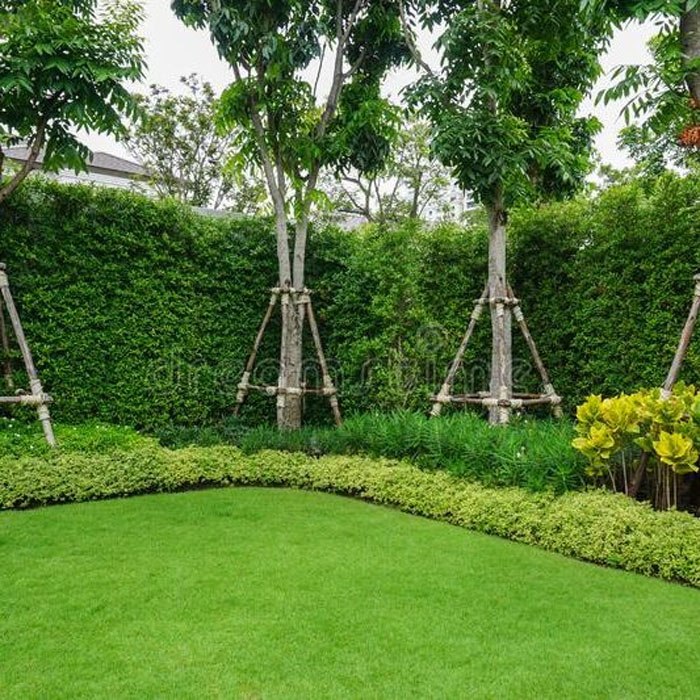The adage stating that “You’re only as strong as your weakest link” can also be said for trees. A tree is only as sturdy as its frailest union. A vast majority of the crown, branch and trunk failures are affiliated with a frail area at the failure point. Cavities, co-dominant stems, and include bark are just among the common issues that afflict trees. Most people are aware of the exploding characteristics of Bradford Pear trees. The codominant quality of the Bradford results in the branches growing alongside each other, which causes a section of included bark to grow and form a weak union. This is a perfect example of structural problems that can befall trees. There are a plethora of circumstances, factors, and defects that can compromise the structural integrity of trees. When it comes to detecting these exacerbating factors, our Isa certified arborists are more than proficient. When a structural flaw has been pinpointed, in order to lessen the risk, a supplemental support system will have to be fitted. Every scenario is different and will need the experience and expertise of an Arborist conversant with guying, bracing, cabling, as well as other support structures. Here are some instances of frequent structural problems and kinds of support systems that we fit to mitigate the problem.
Common Structural Problems
Co-dominant stems
This is the most frequent structural imperfection located in trees. The phrase co-dominant speaks for itself. In a nutshell, the word is used to define 2 or more primary stems that dominate or share the main trunk. In some cases, this doesn’t necessarily have to be a bad thing. We evaluate various factors when we inspect the union joint. We first check the shape of the part where the stems come together. If the union has a V shape, it is an indication of poor adhesive wood development and rivalry amid the stems. If the union is U shaped, there’s no need to worry. When examining the V shaped unions or crotches, we take special interest in the ‘Branch bark ridge’ in arborist terminology. A raised arc on the ridge is an indication that there’s no included bark while an inward turn on the ridge points to bark inclusion. A reaction growth is denoted by excessive swelling at the union. What’s more, we examine any indications of oozing sap or decay pockets that would further escalate the chances of failure.
Cracks in unions
Cracks tend to form in codominant unions. They are difficult to identify and can even go unnoticed for several years. Unions with scar tissues are an indication of crack that has started healing. You should note that this scar tissue only assists the vascular system close off and will not necessarily point to the structural wood healing of the tree. Cracks in unions often arise from strong wind.
Cavities
Trunks, limbs, or holes in branches are all weak spots. These parts may experience cracks for a myriad of reasons. Some of them include insect access points, winterization cracks, old pruning wounds that don’t seal off, and decay organisms. When the internal wood is left bare, the tree will start to rot. This will in turn result in a structural deficit in that section of the tree.
Types of Support Systems
Cabling
Tree cabling is intended to reinforce a tree with structural faults like cavities, cracks, codominant stems, or other exasperating factors. When wind nudges against the top sections of the canopy, it causes a tremendous amount of strain on the weak areas because of the amount of force exerted, which makes it fail. Cabling mitigates the exerted force by fortifying the weak areas of the tree to others.
Cabling systems come in two basic types.
Static Cabling
Static cabling is used in static systems and features Extra High Strength (EHS) steel cable with no give. The cable is often fixed firmly to the tree with wire stops, lag bolts, or steel eye hooks. Static systems are often fitted when you don’t want the crown to move.
The first thing when setting up a static cabling system is establishing the precise spot where the cables will be connected. Additional support cables are affixed 2/3-3/4 of the distance between the union and the upper portion of the tree or the extremity of the branch. When the spot has been established, the fasteners are connected. There are basically three types of fasteners: Wire stops, threaded lag hooks, and eye bolts. We recommend going for the wire stop connectors. If a through wire stop or eye bolt is utilized, a hole will need to be drilled and the wire or rod inserted. If lag hooks are the preferred anchor, they can just be bolted into the tree. Once the holes have been made, the cable will get measured, cut, and fitted.
Dynamic Cabling
Dynamic systems use a specialized interlaced rope with elastic properties to enable movement. The trees will build more wood as it sways with the wind. Dynamic cabling systems are excellent practical systems that avoid failure but may not necessarily be ideal for a tree that has already started failing.
Bracing
Bracing is often done near the union or crotch. It is a very simple process as a matter of fact. The first thing to do is to establish the size and number of rods required to stand the underlying weight of stressed sections. If the tree has experienced a considerable amount of disjointing, other tensioning devices or a come-along will be used to seal off the crack. When that is complete, holes will be made all through the trunk(s). To ensure a tight fit, the holes drilled will be 1/16 inch smaller compared to the rod that will be fitted. When the holes have been made, the laced steel rod will be put in all the way through and fastened with nuts and washers. Cabling is usually done in unison with bracing.
This photograph illustrates how trees react to bracing and cabling hardware. As time lapses, the trees grow new bark and tissue that encapsulates the hardware. The new wood gives off a sturdier anchor point and boosts the support system’s overall strength.
If you think that your tree would be suited for bracing and cabling, please reach out to us for quick service.

